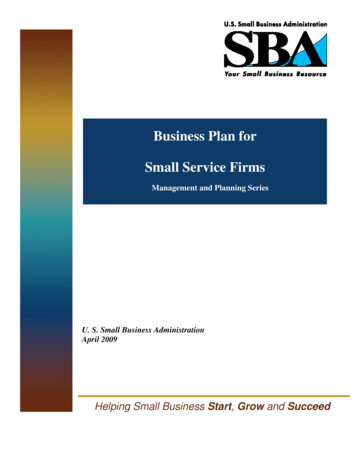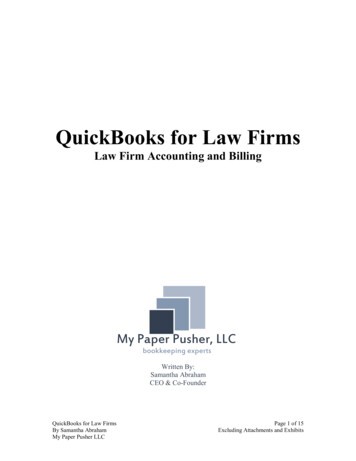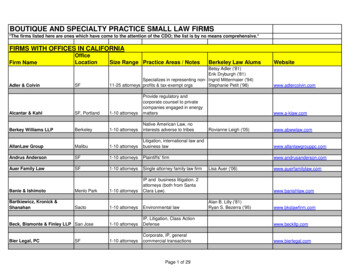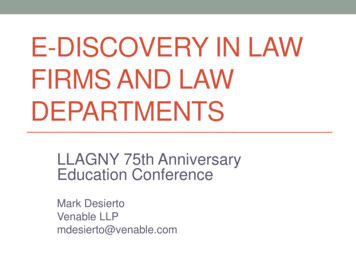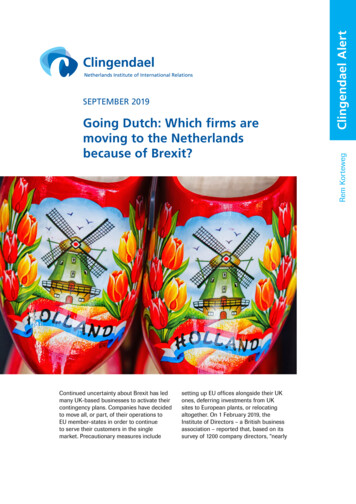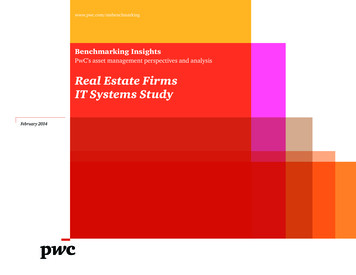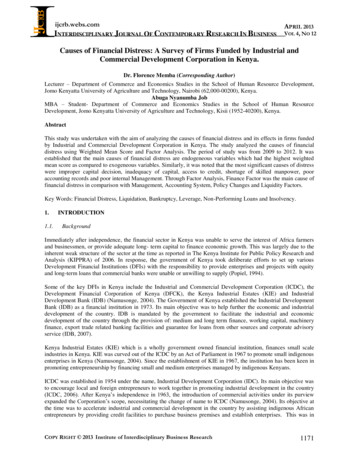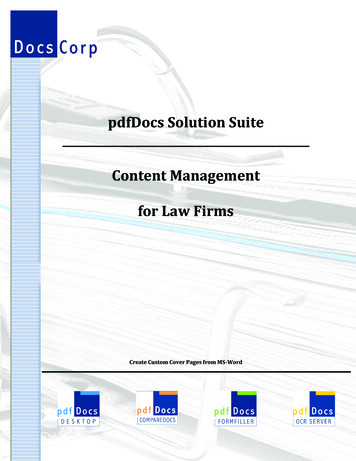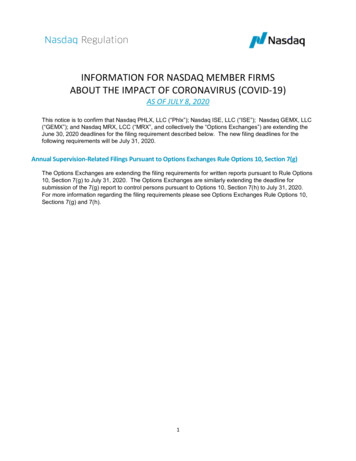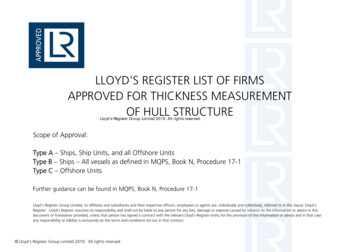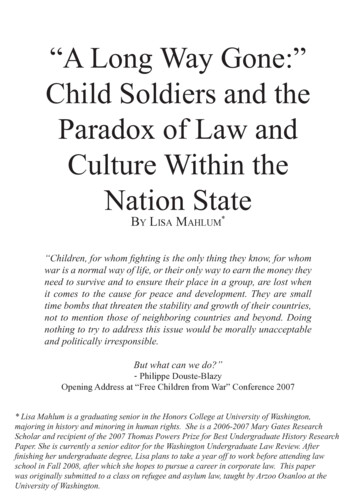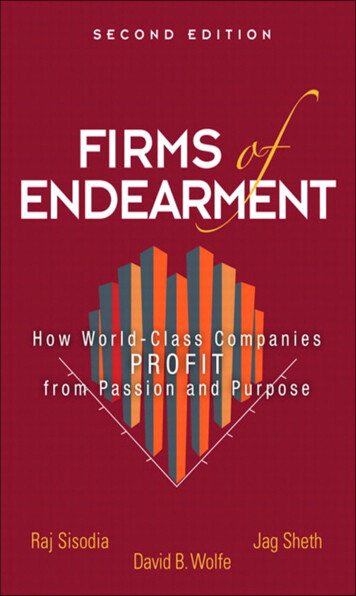
Transcription
Firms of Endearment
This page intentionally left blank
Firms of EndearmentHow World-Class Companies Profit fromPassion and PurposeSecond EditionRaj SisodiaJag ShethDavid Wolfe
Vice President, Publisher: Tim MooreAssociate Publisher and Director of Marketing: Amy NeidlingerExecutive Editor: Jeanne Glasser LevineDevelopment Editor: Natasha TorresOperations Specialist: Jodi KemperCover Designer: Chuti PrasertsithManaging Editor: Kristy HartProject Editor: Elaine WileyCopy Editor: Bart ReedProofreader: Williams Woods PublishingIndexer: Lisa StumpfSenior Compositor: Gloria SchurickManufacturing Buyer: Dan Uhrig 2014 by Rajendra S. Sisodia, Jagdish N. Sheth, and the Estate of David WolfePublished by Pearson EducationUpper Saddle River, New Jersey 07458For information about buying this title in bulk quantities, or for special sales opportunities (which may include electronic versions; custom cover designs; and content particularto your business, training goals, marketing focus, or branding interests), please contactour corporate sales department at corpsales@pearsoned.com or (800) 382-3419.For government sales inquiries, please contact governmentsales@pearsoned.com.For questions about sales outside the U.S., please contact international@pearsoned.com.Company and product names mentioned herein are the trademarks or registered trademarks of their respective owners.All rights reserved. No part of this book may be reproduced, in any form or by anymeans, without permission in writing from the publisher.Printed in the United States of AmericaFirst Printing February 2014ISBN-10: 0-13-338259-1ISBN-13: 978-0-13-338259-4Pearson Education LTD.Pearson Education Australia PTY, Limited.Pearson Education Singapore, Pte. Ltd.Pearson Education Asia, Ltd.Pearson Education Canada, Ltd.Pearson Educación de Mexico, S.A. de C.V.Pearson Education—JapanPearson Education Malaysia, Pte. Ltd.Library of Congress Control Number: 2013954305
We dedicate this book to the memory of ourdear friend David Wolfe—a deep thinker, brilliant writer,and wise and caring human being.Our lives and those of countless others weregreatly enriched by his presence.—Raj Sisodia and Jag Sheth
This page intentionally left blank
ContentsForewords. xPrologueA Whole New World . xxiChapter 1Building Business on Love and Care .1The Power of Love. 4What Is a Firm of Endearment? . 6FoE Stakeholders. 11Identifying the Original Firms of Endearment . 12Firms of Endearment vs. Good to Great Companies . 15Selecting Companies for the Second Edition . 16The Unspoken Contract That FoEs Honor . 20The FoE Way . 22Endnotes . 24Chapter 2New Age, New Rules, New Capitalism .27The Self-Actualization of Capitalism. 29Shareholders versus Stakeholders . 34Emotionally Intelligent Management in FoEs . 38Finding the Will to Change . 40Endnotes . 44Chapter 3Dealing with Disorder .49The Communications Challenge . 52Endnotes . 57Chapter 4Employees: From Resource to Source .59FoEs Put Meaning into the Work Experience . 62The Partnership Advantage in Management-UnionRelationships . 65Building Trust . 67The Joy of Work . 69Training and Development Are Priorities in FoEs . 75Recognition and Celebration Have High Priorityin FoEs . 77How FoEs View Part-Time Employees . 78Connecting Top to Bottom . 79
viiiFIRMS OF ENDEARMENTThe HR Department of the Future . 80Benefits That Flow to Shareholders fromDoing It Right . 81Endnotes . 83Chapter 5Customers: Healing vs. Hucksterism .87The New Marketing Paradigm . 87A New Consciousness . 93It’s Not News: Committed Employees YieldCommitted Customers . 96How Not to Build Trust . 99FoEs Are Soulful. 101Endnotes . 102Chapter 6Investors: Reaping What FoEs Sow .105The Whole Foods Way to Shareholder Wealth . 106Who Are Today’s Investors? . 107The Zen Way of Viewing the Pursuit of Profit . 109Bonding Investors, Employees, and Customers . 112Shareholder Returns . 113Conclusion. 117Endnotes . 117Chapter 7Partners: Elegant Harmonies .119Measures That Matter . 122Stakeholder Concinnity vs. Exploitation . 126Making Stakeholders Partners Increases SuccessPotential . 127Collaboration Is More Profitable Than Exploitation. 132The Art of Ironic Management . 134Endnotes . 139Chapter 8Society: The Ultimate Stakeholder .141Business Values vs. Human Values . 142Pirate or Great Humanitarian?. 144FoEs and Society . 146Endnotes . 161Chapter 9Culture: The Secret Ingredient .163The Greatest Place to Work? . 163The Primacy of Culture . 166
CONTENTSixUnleashing Organizational Energy . 169Setting Organizational Vision: Seeing theLarger Picture . 169Nurturing Organizational Values by BuildingEndearing Cultures. 178FoE Cultural Characteristics. 179Culture DNA . 186Endnotes . 187Chapter 10What We Have Learned .191Distinguishing Traits of Firms of Endearment . 191Challenging Industry Dogma . 192Aligning Stakeholders’ Interests . 193Breaking Traditional Trade-Offs . 196A Long-Term Perspective . 198Organic Growth . 199Blending Work and Play . 199Rejecting Traditional Marketing Models . 201Conclusion. 201Endnotes . 202Chapter 11The Other Side of Complexity .205The Big Challenge of the Times: Transcending aZero Sum Mindset . 211FoE Management Requires Holistic Thinking . 215Getting to the “Other Side of Complexity” . 217Conclusion. 220Endnotes . 222Appendix A Brief Company Profiles .223U.S. Public Firms of Endearment. 223U.S. Private Firms of Endearment . 235Non-U.S. Companies . 247Endnotes . 252Appendix B Interview with Rick Frazier.257Index .267
ForewordsForeword to the First EditionTelevision producer and writer Norman Lear once told me,“When I’ve been most effective, I’ve listened to my inner voice.”Lear’s inner voice gave him the courage to transform television’s voicewith his society-mocking domestic comedy All in the Family. Despitea string of impressive television successes, the raw texture of All in theFamily made it a tough sell. But Lear was driven by a sense of missionon behalf of the entire country. His persistence paid off when CBSfinally agreed to run the show.Confident that one person can bring about big changes, Learforced us to examine some of the most fetid prejudices that bubbledbelow the surface of society in the early 1970s. When All in the Family debuted, teeming throngs demanding civil rights for all and an endto the war in Vietnam swarmed in the nation’s streets and on its college campuses. America’s easy-going post–World War II composurewas dissolving. Lear thought it was time that we tuned into our innervoices to hear what they had to say about how well we honored ourclaim to be a just society.Firms of Endearment brings to mind Lear’s respect for the counsel of his inner voice. Judging by recent headlines, corporate Americahas too few leaders who open their mental ears to their inner voices.Rather, they take cues for their behavior from the external worldwhere pursuit of power over others is the daily priority. Sadly, suchambitions weigh on us with a pervasive presence that extends farbeyond the world of business. We are regularly served up headlinescalling attention to abuses of power in government, academe, clinical research centers, social service agencies, and religious organizations. We seem overrun these days with people in high positions whocompromise their organizations and the general welfare with theirpropensities for self-aggrandizement, avarice, and other perversionsof public and private trust.Happily, Firms of Endearment gives us hope that we are not morally going to hell in a handbasket, a relentless stream of headlines
FOREWORDSxiabout moral failures in high office notwithstanding. The men andwomen cited in this book, as exemplars of conscionable leadership,give us reason for optimism about the character of our future leadersin business and other sectors of society.These executives operate by a guiding vision of service that takesinto account all their primary stakeholders: customers, employees,suppliers and partners in the supply chain, the communities in whichthey operate, and, of course, their investors. Their companies follow a stakeholder relationship management business model ratherthan a traditional stockholder-biased business model. At all levelsof operation, these companies exude the passion of their leaders fordoing good while doing well. Following Polonius’s advice to his sonin Hamlet, these leaders are true to themselves. They evidence keenself-knowledge and project candor and maturity—three essential elements of integrity—in their interactions with others. In return, stakeholders in every category place uncommon trust in their companiesand products. Beyond this, stakeholders develop a real affection forsuch companies. They literally love firms of endearment (FoEs).It is not too much of a stretch to see that as FoEs proliferate—and they are doing that—the principles of leadership that guide theirdestinies will be adopted by organizations of every stripe. Indeed, thefuture well-being of this country could depend more than a little onexecutive leadership of the caliber and mindset described in this book.With a title that stands for the empathetic concern of companiesthat wear their hearts on their sleeves, this book is about the pragmatic role of love in business. However, this is not new ground, asthe authors note. Tim Sanders, then chief solutions officer of Yahoo!,lauded the idea of making love a strategic cornerstone of a company’soperations in his 2002 book Love Is the Killer App: How to Win Business and Influence Friends. He wrote, “I don’t think there is anythinghigher than Love . Love is so expansive. I had such a difficult timecoming up with a definition for Love in my book, but the way I defineLove is the selfless promotion of the growth of the other.” Three yearslater, Kevin Roberts, head of one of the world’s largest ad agencies,Saatchi & Saatchi, wrote of brands transcending the mundane foundations of branding to reach a higher level of existence calling them“lovemarks.” He put forth this idea in a book titled Lovemarks: TheFuture Beyond Brands.
xiiFIRMS OF ENDEARMENTFirms of Endearment is a paean to leaders driven by a strongsense of connectivity to their fellow beings. It celebrates leaders wholeverage their humanness by inspiring others to join them in makingthe world a better place. A few years ago, Timberland CEO JeffreySwartz accepted a friend’s invitation to spend a half a day in a teenhalfway house. His friend promised him that his life would never bethe same. After answering a troubled teen’s question about what hedid (“I’m responsible for the global execution of strategy”), he askedthe teen what he did. “I work at getting well.” Swartz said later thatthe teen’s answer trumped his own answer.Swartz’s friend was right. His life changed that day. He left hisoffice as a hard-driving executive striving to make Timberland the biggest and best in its category and returned as an inspired leader benton enlisting his entire company in a campaign to “make the world abetter place.” That is literally how Jeff Swartz describes his company’smission today. Doubtless, some will charge Swartz with shortchanging his stockholders. However, the stock of this footwear and outdoorapparel company has risen more than 700 percent over the past tenyears. It has better than doubled in the past three.The effectiveness of FoE leadership testifies to something mostof us have known for a long time but have generally not felt comfortable talking about it in our organizations: Praiseworthy leadersachieve greatness by inspiring love in others for their vision.Judging by the stories in this book, Yahoo!’s Tom Sanders is absolutely right: Love is the killer app. Love helped turn FoE SouthwestAirlines into the most successful airline in history—33 years of unbroken profitability. Appropriately, its stock symbol is LUV. Co-founderHerb Kelleher consciously developed a culture of love that ironicallyencompasses his employees’ unions. FoE Commerce Bank’s founder,Vernon Hill, adapted the “love is the killer app” idea to banking tomake Commerce the fastest organically growing bank in America.The culture of love nurtured by FoE Costco co-founder Jim Sinegalprotects shareholders against ill-taken management decisions basedon the demands of Wall Street analysts who would have Costco payemployees less, pare back their benefits, and charge customers more.It would be good enough that FoEs simply did well by their nonshareholder stakeholders while modestly rewarding their investors.
FOREWORDSxiiiHowever, as the authors show, FoEs have generally rewarded theirshareholders to an astonishing degree.In the end, this book is about leadership and the culture thatleaders of FoEs develop and nourish. When asked about their biggest competitive advantage, most CEOs of FoEs say it is their corporate culture. Southwest Airlines so much believes this that it hasa 93-member Culture Committee. The committee’s job is to ensurecontinuation of the culture that has made Southwest arguably themost successful airline in history. Committee membership includesemployees from every level.It is hard to imagine the executives we have recently seen ledaway from their companies in handcuffs spending much time thinkingabout their corporate cultures. True leaders focus less on their ownself-interests than on the interests of the whole. They believe that thefull well-being of one depends on the well-being of all. Leaders whofocus on their own gains in running a company or other organizationare not true leaders. They may be positioned as the head of a globalenterprise, a branch of government, a congressional office, a majoruniversity, or a local parish, but they are leaders in name only. Theycommand others only by virtue of their positions, not by the contentof their character. They are so consumed with self-interest that theyare blind to the well-being of others.All that said, this book makes it easier to imagine that somedaynot far down the road everyone will demand of leaders in business,corporations, and every other type of organization the kind of impassioned pursuit of a broader purpose found in FoEs. As the authors ofthis remarkable book observe, two things have happened to make thatso. The first is the Internet. As it entered the mainstream of society,it dissolved the information advantage organizations have traditionallyhad over their constituencies. The Internet has shifted the balance ofinformation power to the masses. This has made it much harder tohide the misdeeds of morally deficient leaders and organizations.The second event is the aging of the population. For the first timein history, people 40 and older are the adult majority. This is drivingdeep systemic changes in the moral foundations of culture. Higherlevels of psychological maturity mean greater influence on societyof what Erik Erikson called “generativity”—the disposition of older
xivFIRMS OF ENDEARMENTpeople to help incoming generations prepare for their time of stewardship of the common good.Abraham Maslow spoke of people who operate at the higherreaches of maturity as being concerned about matters beyond theirown skins. That sums up the disposition of FoEs. With clear-mindedcertainty about the correctness of their balance between the pursuitof purpose and profits, the leaders of FoEs involve their companiesin matters beyond their immediate boundaries—generally with felicitous results for shareholders.Warren BennisUniversity Professor; Distinguished Professor ofBusiness AdministrationUniversity of Southern CaliforniaFirst Foreword to the Second EditionI was one of the lucky few who had an opportunity to read thewonderful business book Firms of Endearment while it was still inmanuscript form prior to publication. A good friend of mine, KathyDragon, was on an airplane several years ago and just happened to beseated next to David Wolfe, one of the co-authors of the book. Davidwas excited about the book, and when he described its content hementioned that Whole Foods Market was one of the companies theyhad profiled as a “firm of endearment.” Kathy became excited whenshe heard this and told David about her close friendship with me, andthat I would no doubt enjoy reading the book. David gave her a copyof the manuscript to pass on to me to read.Such are the small coincidences that can change people’s lives andalter our destinies. To say that I read Firms of Endearment would be agross understatement—I devoured it. Of course I was very happy thatWhole Foods was one of the 18 public companies they featured in thebook, but that was only the beginning of the impact this book had onme. I was already quite familiar with Stakeholder Theory through myreading of Ed Freeman’s original and brilliant work on the subject,but I was unaware that there were several other companies besidesWhole Foods Market that were conducting their businesses in such
FOREWORDSxvsimilarly conscious ways. Up until that point, I had believed thatWhole Foods was some kind of unusual odd duck that had created aunique business culture based on fulfilling our higher purposes as abusiness (besides just making a profit) and consciously creating valuefor all of our major interdependent stakeholders (customers, employees, suppliers, investors, communities, and the environment). I hadthought we were virtually alone in the world and I was overjoyed todiscover that there were other well-known businesses that thoughtand acted in much the same way.After reading Firms of Endearment, I soon met with David andRaj. We discovered that we shared many ideas and had a commitment to “evangelize” our ideas to the larger world. We began a dialog discussing the ideas outlined in Firms of Endearment—ideas thatI had been calling “Conscious Capitalism.” We believed that theseideas deserved a much larger audience, and we began to plan ourfirst Conscious Capitalism conference to bring together like-mindedpeople into dialog.With an initial modest gathering of about 20 people, we launchedan initiative to spread the ideas of Conscious Capitalism throughoutthe world. Many much larger and hugely successful conferences havefollowed over the past six years. It was at one of these conferences inBoston that I was able to meet the third author of Firms of Endearment, the renowned marketing scholar Jag Sheth. Jag has been a prolific author of dozens of books, including the classic The Theory ofBuyer Behavior and Clients for Life. For many years, Jag served asRaj’s mentor, and in that role alone his contribution to the ConsciousCapitalism movement has been immense.Business is by far the greatest value creator in the world. As Rajand I state it in our book Conscious Capitalism (Harvard BusinessReview Publishing, 2013), “We believe that business is good becauseit creates value, it is ethical because it is based on voluntary exchange,it is noble because it can elevate our existence, and it is heroic becauseit lifts people out of poverty and creates prosperity.” Business hassuch enormous potential to do good in the world. Much of the goodis currently being done “unconsciously” simply by creating productsand services that people value, providing jobs, and generating profits. However, business can also be done much more consciously,with higher purpose and optimal value creation for all of the major
xviFIRMS OF ENDEARMENTstakeholders while creating cultures that optimize human flourishing.As people, particularly leaders, become more conscious, we are ableto create new types of entrepreneurial enterprises that will help solveour most serious problems and will evolve humanity upward to fulfillour unlimited potential as a species. Firms of Endearment is a veryimportant and ground-breaking book because it points the way thatall businesses should aspire to emulate and ultimately transcend. I amgrateful to the authors for their landmark contribution to elevatingbusiness practice and thereby benefiting humanity.John MackeyCo-founder and Co-CEO of Whole Foods MarketSecond Foreword to the Second EditionThis new edition of Firms of Endearment continues to breakimportant new ground in understanding the power of capitalism totransform our world for the better. In the first edition the authorssuggested that firms that pay attention to how they create value forstakeholders might perform better. They gave us an introductoryquantitative analysis and a set of rich stories that made the analysismake some sense.In this new edition they take a giant step forward. They give usa “proof of possibility,” thereby grounding a new story of businessin solid economic analysis and practical management thinking. Therole of passion and purpose is not well understood in a world wherethe dominant story of business that we read everyday suggests thatonly money and profits count. Furthermore, this dominant story suggests that businesspeople are greedy and self-interested. We see thisplayed out everyday in the press, in government responses to crises, and sometimes we see executives themselves making the sameattributions.It’s time to stop this nonsense, and the authors give us a roadmap.Every business always has and always will create value for customers, employees, communities, suppliers, and the financiers whoput up the investment. Firms of endearment are those companiesthat realize this principle of stakeholder value creation and orient
FOREWORDSxviithemselves around it. These are the companies we love to do businesswith. They are the brands we recommend to our friends, and if weare smart, they are the investments we have in our portfolios, 401(k)plans, and so on.None of what this book says should be surprising. What is surprising is the resistance that can be encountered. Many narrow-mindedeconomists, as well as many critics of business, just “know” that business is really about the money. They then make the logical error ofinferring that the purpose of business is to make as much money aspossible. That’s like saying that because we need red blood cells tolive, the purpose of life is to make red blood cells.Our great companies, including the ones in this book, but inthe past as well, are fueled by passion and by a sense of purpose.Great business leaders channel their employees’ desires to be a partof something bigger than themselves and to be a part of making theworld a better place for their children into the overall purpose of theirbusiness. Profit is an outcome. And, of course, there are no guarantees here. Sometimes companies do their best around a purpose andindeed fail, or they fail to keep that purpose in front of them, or conditions simply change.The twenty-first century requires a new way of thinking aboutbusiness. Thankfully that story is beginning to emerge with books likeFirms of Endearment. It will repay close study, seeing how your company is both like and unlike the examples in the book. And, hopefullyit will cause you to ask questions about your own purpose, both interms of your company and your individual situations.This is not the end of the new story of business, but it is a goodbeginning. Hopefully it will inspire others to “critique by creatingsomething better.” I urge you to see it not as the definitive word onhow to run a business, but as a proof of possibility that creating valuefor stakeholders with purpose and passion is an idea that works andwhose time has come. It offers hope that we can be the generationthat makes business better and leaves a better world for our children.R. Edward FreemanUniversity Professor; Elis and Signe Olsson Professor ofBusiness AdministrationThe Darden School, University of Virginia
AcknowledgmentsWe would like to acknowledge the valuable assistance of JohnWarden and Alex Romeo in helping conduct the financial analysis ofthe firms. We also appreciate the many conversations we had with RickFrazier on how to evaluate companies using a stakeholder approach.His insights and suggestions have been invaluable. Jeff Cherry andPeter Derby have also been very helpful in this regard.Many people have been great supporters of the original Firms ofEndearment. Their insights and suggestions have been very valuableto us in making this revision. In particular, we would like to thankJohn Mackey, Kip Tindell, Shubhro Sen, Abilio Diniz, Fred Kofman,Ricardo Gil, Doug Rauch, Doug Levy, Rand Stagen, Vinit Taneja,Kiran Gulrajani, Dr. Manesh Shrikant, Harsh Mariwala, DebashisChatterjee, Vineeta Salvi, Tony Buono, Alan Hoffman, Michael Gelb,Howard Behar, Youngsul Kwon, Michael Lee, Ashwini Malhotra,Sudhakar Ram, Ketan Mehta, Ashank Desai, R. Sundar, and RoySpence.Raj Sisodia acknowledges the work of his many students at Bentley University in evaluating numerous companies over the yearsusing the criteria laid out in this book. He would also like to thank hisdaughter Maya for her editorial work on the book.Jag would like to thank Joey Reiman and Suhas Apte for theirenthusiasm and encouragement to revise the book. He would also liketo thank Ishan Dey, Aarya Budhiraja, and Rohan Parekh for providing research support. Finally, he thanks his personal assistant, NicoleSmith, for her administrative support.
About the AuthorsRaj Sisodia is the F.W. Olin Distinguished Professor of GlobalBusiness and Whole Foods Market Research Scholar in ConsciousCapitalism at Babson College in Wellesley, MA. He is also co-founderand co-chairman of Conscious Capitalism, Inc. He has a Ph.D. inmarketing from Columbia University. Raj is the co-author of The NewYork Times bestseller Conscious Capitalism: Liberating the HeroicSpirit of Business (Harvard Business Review P
coming up with a definition for Love in my book, but the way I define Love is the selfless promotion of the growth of the other.” Three years later, Kevin Roberts, head of one of the world’s largest ad agencies, Saatchi & Saatchi, wrote of brands transcending the mundane foun-dations of b
